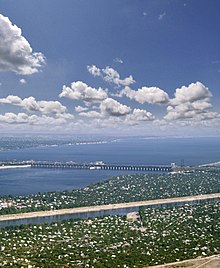This article includes a list of general references, but it lacks sufficient corresponding inline citations. (January 2013) |
| Volga Hydroelectric Power Station | |
|---|---|
 | |
| Official name | Волжская ГЭС |
| Location | Volga, Russia |
| Coordinates | 48°49′34″N 44°40′19″E / 48.82611°N 44.67194°E |
| Construction began | 6 August 1950 |
| Opening date | 10 September 1961 |
| Operator(s) | RusHydro |
| Dam and spillways | |
| Impounds | Volga River |
| Height | 44 m (144 ft) |
| Length | 725 m (2,379 ft) |
| Reservoir | |
| Creates | Volgograd Reservoir |
| Total capacity | 31.5 km3 (8 cu mi) |
| Surface area | 3,117 km2 (1,203 sq mi) |
| Power Station | |
| Turbines | 1 × 115.0 MW 16 × 125.5 MW 5 × 120.0 MW 1 × 11.0 MW |
| Installed capacity | 2,734 MW[1][2][3] 2,744.5 MW (max) |
| Annual generation | 10,999 GWh[4] (2015) |
| Static inverter of HVDC Volgograd-Donbass on dam | |

The Volga Hydroelectric Station or Volga GES (Russian: Волжская ГЭС) also known as the 22nd Congress of the CPSU Stalingrad/Volgograd Hydroelectric Power Station (Russian: Сталинградская/Волгоградская ГЭС имени XXII съезда КПСС), is the largest hydroelectric station in Europe, and the last of the Volga-Kama Cascade of dams, immediately before the Volga River flows into the Caspian Sea. It was the largest powerstation in the world between 1960 and 1963.[5] Today, it is operated by the partly government-owned electricity company RusHydro.
- ^ "Волжская ГЭС увеличила установленную мощность в результате модернизации оборудования".
- ^ "Общие сведения". Archived from the original on 25 March 2019. Retrieved 16 April 2019.
- ^ "На крупнейшей ГЭС Европы начата модернизация очередного гидроагрегата".
- ^ "2015".
- ^ "Проектирование, строительство и эксплуатация ГЭС". Archived from the original on 4 July 2016. Retrieved 23 August 2017.